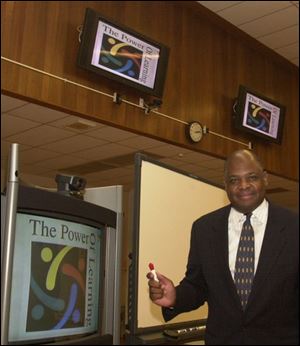
Video system gives TPS a statewide voice
6/20/2001
`We can't wait to test it,' says Superintendent Eugene Sanders, with the new video-conferencing equipment.
A video-conferencing unit costing nearly $70,000 is Toledo Public School's newest tool in joining a statewide network that connects all of the state's public and charter schools.
The video-conferencing unit now being set up in the school board's meeting room at 420 Manhattan Blvd. could eventually be used to provide classes over the Internet.
Superintendent Eugene Sanders said he's trying to arrange a demonstration with the superintendent of the Houston school district.
“We can communicate live, interactively with anyone else in the world,” Dr. Sanders said. “We can't wait to test it.”
Eventually, it can be used to provide classroom instruction online to individuals with home computers or to groups of students at distant sites, according to Dan Burns, acting assistant to the business manager, who's overseeing the installation.
The unit includes two large, wall-mounted screens. One displays the people on the other end of the video conference. The second is a monitor displaying the group in the Toledo board room. A cable connects the unit to Buckeye Cablevision, which provides the link to AT&T, the state's carrier for the network.
Mr. Burns said that by the end of the summer, each of the more than 65 school buildings will be converted to the network. The connections will allow schools to communicate with video, data, and voice between each other as well as with every other public school in the state.
The unit will also allow the use of PowerPoint presentations and will permit the superintendent to communicate with each school from the board office.
Mr. Burns said he will soon apply for state grants of $80,000 per building to pay for the installation of video-conferencing equipment in the schools. The supplier is Total Systems Integration, Inc., Galion, Ohio, one of three suppliers approved by the state without a bids.
The equipment was bought with federal E-rate funds, part of a $4 billion federal program aimed at making sure all schools are wired to the Internet, Mr. Burns said.
Toledo's improvements tie in with a $58 million state program to connect all the public schools in Ohio to a single network that allows instant data, voice, and video connections.
The funding is available only to public and charter schools.
The Toledo public school district received grants totaling $735,000 from Onenet, the project established by a state law in 1999.
Onenet is operated under SchoolNet, the state's agency for installing computers in public schools.
Scott Gaughan, the project manager for Onenet in Columbus, said it will be one of the largest networks in the country when completed at the start of the coming school year.
“Multimedia and distance learning are just starting to take hold and are going to shape the way education is being delivered,” Mr. Gaughan said. “They have access to all the other schools, and content providers like the zoos and museums.”
He said Onenet could be used to supply online education. Currently, only the Electronic Classroom of Tomorrow, a statewide Internet charter school, provides regular education online. ECOT, which is chartered by the Lucas County Educational Service Center, started in September.